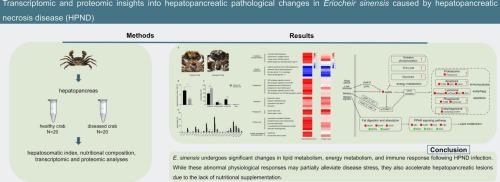Integrated transcriptomic and proteomic analysis of hepatopancreatic pathological changes in Eriocheir sinensis affected by hepatopancreatic necrosis disease
IF 2.2
2区 生物学
Q4 BIOCHEMISTRY & MOLECULAR BIOLOGY
Comparative Biochemistry and Physiology D-Genomics & Proteomics
Pub Date : 2025-08-11
DOI:10.1016/j.cbd.2025.101608
引用次数: 0
Abstract
Hepatopancreatic necrosis disease (HPND) has had a significant impact on the aquaculture industry of Eriocheir sinensis, yet its pathogenic mechanisms remain controversial. This study investigates the pathological alterations in the hepatopancreas of E. sinensis affected by HPND by comparing the biochemical composition of the hepatopancreas in healthy and diseased crabs, in combination with transcriptomic and proteomic analyses. Our results show that the hepatosomatic index (HSI), as well as crude lipid and crude protein levels, were significantly reduced in HPND-affected crabs compared to healthy ones (P < 0.05). Fatty acid profiling revealed notable changes, with many fatty acids showing significant decreases (P < 0.05). Integrated omics analysis indicated that multiple pathways related to energy metabolism and immune response were enriched in diseased hepatopancreas tissues, including retinol metabolism, oxidative phosphorylation, peroxisome, lysosome, apoptosis, fatty acid degradation, endocytosis, glutathione metabolism, and unsaturated fatty acid biosynthesis. Notably, the AMPK signaling pathway was significantly activated, promoting glycolysis and fatty acid metabolism, inhibiting fatty acid synthesis, and regulating apoptosis and autophagy. This research presents an in-depth analysis of the pathological and molecular alterations in the hepatopancreas of HPND-infected crabs, offering new insights into its underlying pathogenic mechanisms.

肝胰腺坏死病对中华绒螯蟹肝胰腺病理改变的综合转录组学和蛋白质组学分析
肝胰腺坏死病(hpd)对中华绒螯蟹养殖业造成了重大影响,但其发病机制仍存在争议。本研究结合转录组学和蛋白质组学分析,通过比较健康和患病蟹肝胰脏的生化组成,探讨了HPND对中华鄂螯蟹肝胰脏病理改变的影响。结果表明,与健康蟹相比,患hpd蟹的肝体指数(HSI)以及粗脂肪和粗蛋白质水平显著降低(P <;0.05)。脂肪酸谱显示了显著的变化,许多脂肪酸显着减少(P <;0.05)。综合组学分析表明,病变肝胰腺组织中丰富了与能量代谢和免疫应答相关的多种途径,包括视黄醇代谢、氧化磷酸化、过氧化物酶体、溶酶体、细胞凋亡、脂肪酸降解、内吞作用、谷胱甘肽代谢、不饱和脂肪酸生物合成等。明显激活AMPK信号通路,促进糖酵解和脂肪酸代谢,抑制脂肪酸合成,调节细胞凋亡和自噬。本研究深入分析了hhpnd感染螃蟹肝胰腺的病理和分子变化,为其潜在的致病机制提供了新的见解。
本文章由计算机程序翻译,如有差异,请以英文原文为准。
求助全文
约1分钟内获得全文
求助全文
来源期刊
CiteScore
5.10
自引率
3.30%
发文量
69
审稿时长
33 days
期刊介绍:
Comparative Biochemistry & Physiology (CBP) publishes papers in comparative, environmental and evolutionary physiology.
Part D: Genomics and Proteomics (CBPD), focuses on “omics” approaches to physiology, including comparative and functional genomics, metagenomics, transcriptomics, proteomics, metabolomics, and lipidomics. Most studies employ “omics” and/or system biology to test specific hypotheses about molecular and biochemical mechanisms underlying physiological responses to the environment. We encourage papers that address fundamental questions in comparative physiology and biochemistry rather than studies with a focus that is purely technical, methodological or descriptive in nature.

 求助内容:
求助内容: 应助结果提醒方式:
应助结果提醒方式:


